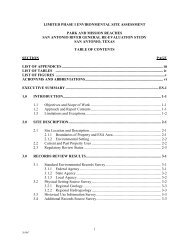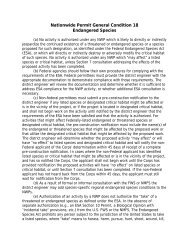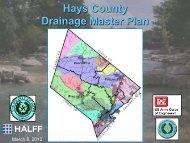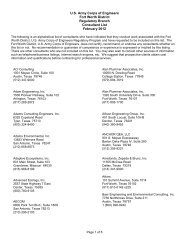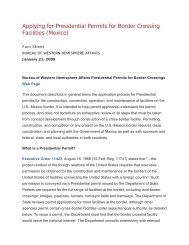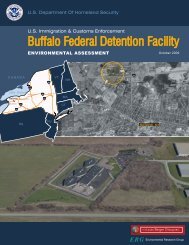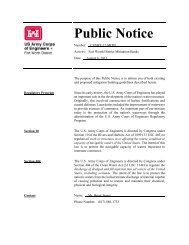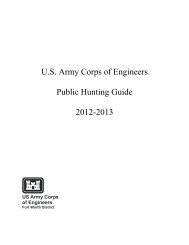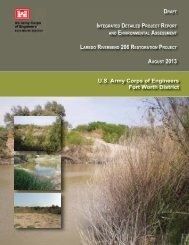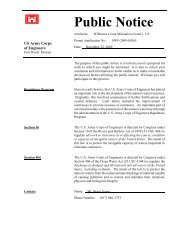environmental assessment us border patrol, tucson sector
environmental assessment us border patrol, tucson sector
environmental assessment us border patrol, tucson sector
You also want an ePaper? Increase the reach of your titles
YUMPU automatically turns print PDFs into web optimized ePapers that Google loves.
3-61234567891011121314151617181920212223242526272829303132333435363738394041424344454647complex, 1 to 15 percent slopes, is well-drained and has moderately to very slow permeability;water availability is high to very high, and runoff rates are medium or high. Outlaw-Epitaph-Paramore complex soils, 1 to 15 percent slopes, are characteristic of volcanic flows and primarilycontain 35 percent Outlaw soils, 25 percent Epitaph soils, and 20 percent Paramore soils. TheOutlaw components of this soil were described previo<strong>us</strong>ly for the Alternative 2 site. Epitaphsoils are comprised of silty clay loam, silty clay, and strongly cemented hardpan andunweathered basalt flow at greater depths. About 30 to 40 percent of the surface is covered withcinders, basalt gravel, and cobbles. Paramore soils consist of silty clay loam, clay, andunweathered basalt flow, and 20 to 30 percent of the surface is covered with cinders, basaltgravel, and cobbles. Outlaw-Epitaph-Paramore complex soils, 1 to 15 percent slopes, originatefrom slope alluvium and residuum derived from basalt, cinders, bombs, and volcanic rocks. Thesoils are well-drained and have very slow permeability; water availability is low, and runoff ratesare medium or high. The Epitaph and Paramore soils have a slight or moderate hazard of watererosion and a moderate hazard for wind erosion.Riveroad and Ubik soils, 0 to 5 percent slopes, are often found in floodplain and alluvial fanareas. This is an undifferentiated soil unit. The soils identified in the name of the unit are notconsistently associated geographically. In general, Riveroad and Ubik soils are comprised of siltloam, silty clay loam loam, silt loam, and fine sandy loam soils which originate from mixedstream alluvium. These soils are well-drained, have moderately slow permeability, high to veryhigh water availability, and a low runoff rate. The hazard of erosion by water and wind is slightfor Riveroad soils.3.3.2 Environmental Consequences3.3.2.1 No Action AlternativeUnder the No Action alternative, there would be no modification of soils since no new structureswould be constructed. More agents would be required to <strong>patrol</strong> the remote eastern zones of theUSBP Douglas Station’s AOR to account for the necessary drive time to their <strong>patrol</strong> areas.Indirect impacts on soils from CBV activities and subsequent USBP interdiction activities wouldbe greater under the No Action Alternative than any of the other alternatives.3.3.2.2 Preferred AlternativeThe development of the Preferred Alternative site would permanently impact up to 10 acres ofEloma sandy loam, 1 to 10 percent slopes, through conversion from undeveloped vacant land todeveloped land with some impermeable surfaces. . Limitations for development of structures onthis soil type include moderate shrink-swell properties, excess rock fragments that interfere withexcavations, and a high clay content that restricts water infiltration and permeability (NRCS2003). BMPs would be implemented to prevent soil erosion off-site due to wind or rain activity,and a National Pollutant Discharge Elimination System (NPDES) permit, including a SWPPP,for development would be obtained. Eloma sandy loam, 1 to 10 percent slopes, is common inthe San Bernardino Valley, so the loss of biological productivity for 10 acres would not beconsidered a major impact3.3.2.3 Alternative 2Impacts on up to 6.7 acres of Elgin-Outlaw complex soils, 1 to 10 percent slopes and up to 3.3acres of Eloma sandy loam soils, 1 to 10 percent slopes soils would be similar to those describedfor the Preferred Alternative. Limitations for development of structures on the soil types foundDouglas FOB EADraftAug<strong>us</strong>t 2011



